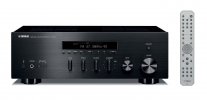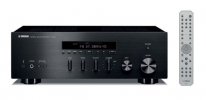-
WANTED: Happy members who like to discuss audio and other topics related to our interest. Desire to learn and share knowledge of science required. There are many reviews of audio hardware and expert members to help answer your questions. Click here to have your audio equipment measured for free!
- Forums
- Audio, Audio, Audio!
- Amplifiers, Phono preamp, and Analog Audio Review
- Stereo and Multichannel Amplifier Reviews
You are using an out of date browser. It may not display this or other websites correctly.
You should upgrade or use an alternative browser.
You should upgrade or use an alternative browser.
Topping PA5 II Stereo Amplifier Review
- Thread starter amirm
- Start date
Martinvb
Active Member
It may actually be a very good idea to have a PA5 II user panel and do a prospective study. Apart from purchase date some other basic info could be useful to collect for post hoc analysis, such as: serial number, main usage balanced or unbalanced, mean output setting. Users should subscribe only if their unit has been flawless so far.The only question is if this unit would be reliable or not, we need at least 6 months and a representative set of users. The previous version was a disaster regarding reliability.
restorer-john
Grand Contributor
It may actually be a very good idea to have a PA5 II user panel and do a prospective study. Apart from purchase date some other basic info could be useful to collect for post hoc analysis, such as: serial number, main usage balanced or unbalanced, mean output setting. Users should subscribe only if their unit has been flawless so far.
Dude, it's just another * Chinese made, IC based amplifier in a can. Disposable rubbish. Not true high fidelity equipment and never was. Except they are charging real money for this junk and suckering in a whole bunch of people who should know better.
It's so disappointing, but not unexpected.
Topping should stick to what they can do reasonably well. D/A converters. Stay out of high current, high voltage, heat producing products. Why? Because they have ZERO skills in that area. They just don't get it. But whatever, I find it funny to watch, especially with all the free help and advice they have been given- they still mange to f#ck it up.
Buy at your own risk. And don't say you weren't warned.
*edited
Last edited:
TheLastGerman
Member
Actually it is a 50Hz test tone.These fit into European wall power plugs. Rumour has it there is a 60Hz test tone at full power in there.
Martinvb
Active Member
Well, Topping must do something right when they are able to produce excellent measuring units. The issue of unreliability of the PA5 (I and II) still remains rather obscure to me, as these units must have been sold (and are currently selling) like hot cakes. Agreed, determining failure rate should be the primary responsibility of the manufacturer, but apparently so far only one member has experienced a bad PA5 II unit, which is no proof of a bad product until you know how many of these things were sold in the first place. That’s where my scientific interest comes in. Some owners seem to buy thes units by the dozen: this adds up to the base rate. Meanwhile, I am an extremely happy owner of a still working PA5, which amazes me every dayDude, it's just another cheap-ass Chinese made, IC based amplifier in a can. Disposable rubbish. Not true high fidelity equipment and never was. Except they are charging real money for this junk and suckering in a whole bunch of people who should know better.
It's so disappointing, but not unexpected.
Topping should stick to what they can do reasonably well. D/A converters. Stay out of high current, high voltage, heat producing products. Why? Because they have ZERO skills in that area. They just don't get it. But whatever, I find it funny to watch, especially with all the free help and advice they have been given- they still mange to f#ck it up.
Buy at your own risk. And don't say you weren't warned.
bboris77
Senior Member
- Joined
- Oct 23, 2018
- Messages
- 450
- Likes
- 935
I always try to be open-minded with any product from any company. When a new product like this is released I always try and think about why I would want/need it and why anyone else would want/need it.
Personally, being situated in North America, I tend to prefer equipment from manufacturers that have local repair facilities in case they need to be shipped back to the mothership. Plus, like Amir says, speaker amplifiers tend to have higher failure rate to begin with. For this reason, even though it is a bit more expensive, I would go with a Yamaha A-S301 if I needed/wanted a stereo or an integrated amplifier.
At the bare minimum, for me to consider buying a stereo amplifier, it would have to have a subwoofer out and a track record for reliability of a period of time.
Two obvious advantages that this Topping unit has over classic class A/B amplifiers like the Yamaha are its very compact size and the fact that it has balanced inputs. It stacks perfectly with most audio interfaces, for example. On the other hand, most people that use audio interfaces tend to run active speakers with their own amplification. This leaves me a bit puzzled in terms of who the intended audience for this product is. Perhaps people who are bothered by the idea of mixing brands when it comes to their audio equipment? Perhaps it’s people who are fascinated with the Class D technology and its efficiency. I would genuinely like to know what prompts people to buy this amp or its predecessor over something like the A-S301.
Personally, being situated in North America, I tend to prefer equipment from manufacturers that have local repair facilities in case they need to be shipped back to the mothership. Plus, like Amir says, speaker amplifiers tend to have higher failure rate to begin with. For this reason, even though it is a bit more expensive, I would go with a Yamaha A-S301 if I needed/wanted a stereo or an integrated amplifier.
At the bare minimum, for me to consider buying a stereo amplifier, it would have to have a subwoofer out and a track record for reliability of a period of time.
Two obvious advantages that this Topping unit has over classic class A/B amplifiers like the Yamaha are its very compact size and the fact that it has balanced inputs. It stacks perfectly with most audio interfaces, for example. On the other hand, most people that use audio interfaces tend to run active speakers with their own amplification. This leaves me a bit puzzled in terms of who the intended audience for this product is. Perhaps people who are bothered by the idea of mixing brands when it comes to their audio equipment? Perhaps it’s people who are fascinated with the Class D technology and its efficiency. I would genuinely like to know what prompts people to buy this amp or its predecessor over something like the A-S301.
Does the PA5 II use the tpa3251 chip, if so is it just the one chip or is it dual mono
The operating voltage range of the 3251 is 12v to 38v, do you think topping have supplied a power supply with too high a voltage. A few start up surges or spikes in the power supply could take the voltage into dangerous territory.
What do you think of the 4amp current rating of the psu, what do you think would be an optimum figure
The operating voltage range of the 3251 is 12v to 38v, do you think topping have supplied a power supply with too high a voltage. A few start up surges or spikes in the power supply could take the voltage into dangerous territory.
What do you think of the 4amp current rating of the psu, what do you think would be an optimum figure
daniboun
Major Contributor
Now we have some pictures and we know more about the pcb : seems same as the RA3 = Single chip TP3251. Only the PA7 Plus uses a dual TPA3251 chip (dual mono configuration). See pictures on previous pages )Does the PA5 II use the tpa3251 chip, if so is it just the one chip or is it dual mono
The operating voltage range of the 3251 is 12v to 38v, do you think topping have supplied a power supply with too high a voltage. A few start up surges or spikes in the power supply could take the voltage into dangerous territory.
What do you think of the 4amp current rating of the psu, what do you think would be an optimum figure
I guess the PSU should be quasi identical to the PA5
Last edited:
daniboun
Major Contributor
This one : https://www.3e-audio.com/amplifier-kits/tpa32xx-with-pffb/I’d love to see a technical review of this board as well. I have all the necessary parts to complete a TP3255 amp, just wondering which is the right board.
It is high fidelity, not an opinion, the numbers tell, and you don't know how reliable this version is, nobody knows, you have a lot of cognitive bias against Chinese products, sorry John you are not being objective.Dude, it's just another cheap-ass Chinese made, IC based amplifier in a can. Disposable rubbish. Not true high fidelity equipment and never was. Except they are charging real money for this junk and suckering in a whole bunch of people who should know better.
It's so disappointing, but not unexpected.
Topping should stick to what they can do reasonably well. D/A converters. Stay out of high current, high voltage, heat producing products. Why? Because they have ZERO skills in that area. They just don't get it. But whatever, I find it funny to watch, especially with all the free help and advice they have been given- they still mange to f#ck it up.
Buy at your own risk. And don't say you weren't warned.
Lräk
Member
I don't have a schematic, but I've probed the board a few times. There is a LM317 regulator that takes the 38v down to 34.7v. I imagine that is used on the 3251 so the power brick can vary quite a bit and not bother the 3251.Does the PA5 II use the tpa3251 chip, if so is it just the one chip or is it dual mono
The operating voltage range of the 3251 is 12v to 38v, do you think topping have supplied a power supply with too high a voltage. A few start up surges or spikes in the power supply could take the voltage into dangerous territory.
What do you think of the 4amp current rating of the psu, what do you think would be an optimum figure
restorer-john
Grand Contributor
Look at the typical SMPS above and tell me how that bodes well for a long life. It doesn’t.It is high fidelity, not an opinion, the numbers tell, and you don't know how reliable this version is, nobody knows, you have a lot of cognitive bias against Chinese products, sorry John you are not being objective.
It’s a sealed plastic box and has no ability to dissipate heat. The internal components actually cook. No 'power' amplifier should be run from such a supply. It should be caged, mounted in the amplifier casework and adequately ventilated.
Last edited:
I wouldn't go that far. I kinda see us approaching something similar to the quartz watch crisis where digital watches which cost 20 dollars are more accurate than a Patek or Rolex. Sound however is much more subjective then how accurate time is, so it may never get to that level for some people that swear the generally more pricey equipment sounds significantly better. I think we have already reached the level of fidelity that is inaudible for 99.9% of people including me. However, I do own several analog watches as well as a smart watch and enjoy both.Dude, it's just another cheap-ass Chinese made, IC based amplifier in a can. Disposable rubbish. Not true high fidelity equipment and never was. Except they are charging real money for this junk and suckering in a whole bunch of people who should know better.
It's so disappointing, but not unexpected.
Topping should stick to what they can do reasonably well. D/A converters. Stay out of high current, high voltage, heat producing products. Why? Because they have ZERO skills in that area. They just don't get it. But whatever, I find it funny to watch, especially with all the free help and advice they have been given- they still mange to f#ck it up.
Buy at your own risk. And don't say you weren't warned.
In terms of the comment, "...cheap-ass Chinese made...", have you used this term for cheap made products from other countries? I would tend to trust you a bit more if you left out the country of origin versus you having some sort of bias or agenda against Chinese made products. I'm not saying you do, but just the terminology you're using seems a bit "iffy" to me. I have no issues supporting electronic companies in my own country, state and even city as I try to shop local for products to help out the local economy, but I don't deem the quality of a product as inferior due to their country of origin.
D
Deleted member 48726
Guest
Ahh come on. In the case of these two examples you absolutely can tell which cabinet works best for convectional cooling by just looking at them. Fosi also connects the chip, via heatsink, directly to the chassis. This one has a heatsink that dumps all the heat inside.You simply can't tell from looking at a product "which device seems like its had more thought devoted to cooling"
Thermal design is just that - a design process. It is not just "drilling holes randomly into a case" until it is cool enough. It will involve consideration of the losses, air flow, location of hot devices, how heat is distributed from that location, and how the heat gets out of the case. It is perfectly possible to design a case with no ventilation holes at all. In the best case it will be simulated before a prototype is even made.
Or until warranty expires.The only question is if this unit would be reliable or not, we need at least 6 months and a representative set of users. The previous version was a disaster regarding reliability.
restorer-john
Grand Contributor
In terms of the comment, "...cheap-ass Chinese made...", have you used this term for cheap made products from other countries? I would tend to trust you a bit more if you left out the country of origin versus you having some sort of bias or agenda against Chinese made products.
OK. I have edited my comment to remove the "cheap-ass" descriptor as I was wrong- it's not actually that cheap.
The product is Chinese made, so that stays.
Roland68
Major Contributor
36-38 volts are the Recommended Operating Conditions. The maximum permissible voltage is 50 volts and should never be exceeded.Does the PA5 II use the tpa3251 chip, if so is it just the one chip or is it dual mono
The operating voltage range of the 3251 is 12v to 38v, do you think topping have supplied a power supply with too high a voltage. A few start up surges or spikes in the power supply could take the voltage into dangerous territory.
What do you think of the 4amp current rating of the psu, what do you think would be an optimum figure
This means that the 38 volt power supplies from Topping are absolutely in the safe area.
By the way, the LM317 is not for the TPA3251, but for the rest of the supply.
The 4Ah power supply is designed by Topping for the performance and range of use of the PA5 II Plus.
KellenVancouver
Addicted to Fun and Learning
- Joined
- Nov 16, 2021
- Messages
- 859
- Likes
- 6,081
Relate to both sides. Sure, let's wait and see how reliability turns out. On the other hand, their products are like an unfaithful wife. Once burned, very hard to trust again.It is high fidelity, not an opinion, the numbers tell, and you don't know how reliable this version is, nobody knows, you have a lot of cognitive bias against Chinese products, sorry John you are not being objective.
restorerJohn: Dude, it's just another * Chinese made, IC based amplifier in a can. Disposable rubbish. Not true high fidelity equipment and never was. Except they are charging real money for this junk and suckering in a whole bunch of people who should know better.
It's so disappointing, but not unexpected.
Topping should stick to what they can do reasonably well. D/A converters. Stay out of high current, high voltage, heat producing products. Why? Because they have ZERO skills in that area. They just don't get it. But whatever, I find it funny to watch, especially with all the free help and advice they have been given- they still mange to f#ck it up.
Buy at your own risk. And don't say you weren't warned.
Roland68
Major Contributor
These completely encapsulated power supplies have been used (tens of millions) in this power class (120 - 200 watts) in IT, industry and the home consumer sector for over 20 years.Look at the typical SMPS above and tell me how that bodes well for a long life. It doesn’t.
It’s a sealed plastic box and has no ability to dissipate heat. The internal components actually cook. No 'power' amplifier should be run from such a supply. It should be caged, mounted in the amplifier casework and adequately ventilated.
The first power supplies were still very warm, but were touchable. But for 15 years, neither heat nor durability has been an issue with these power supplies.
Out of several 100's of these power supplies, I've had to replace less than a handful over a 5-7 year period and many have been running 24/7. And no matter which device these power supplies came with, the country of manufacture was always China.
Sokel
Master Contributor
- Joined
- Sep 8, 2021
- Messages
- 6,123
- Likes
- 6,202
Talking about price I did a little comparison with a same price Yamaha to see how much hardware you get of each (click on the pics to maximize)- it's not actually that cheap.


(green is Topping,red is Yamaha)


The above is without Topping's PSU.
I believe they are comparable in terms of power too.
Attachments
Last edited:
Similar threads
- Replies
- 58
- Views
- 8K
- Replies
- 25
- Views
- 5K
- Replies
- 15
- Views
- 949
- Replies
- 27
- Views
- 5K
- Replies
- 354
- Views
- 72K

